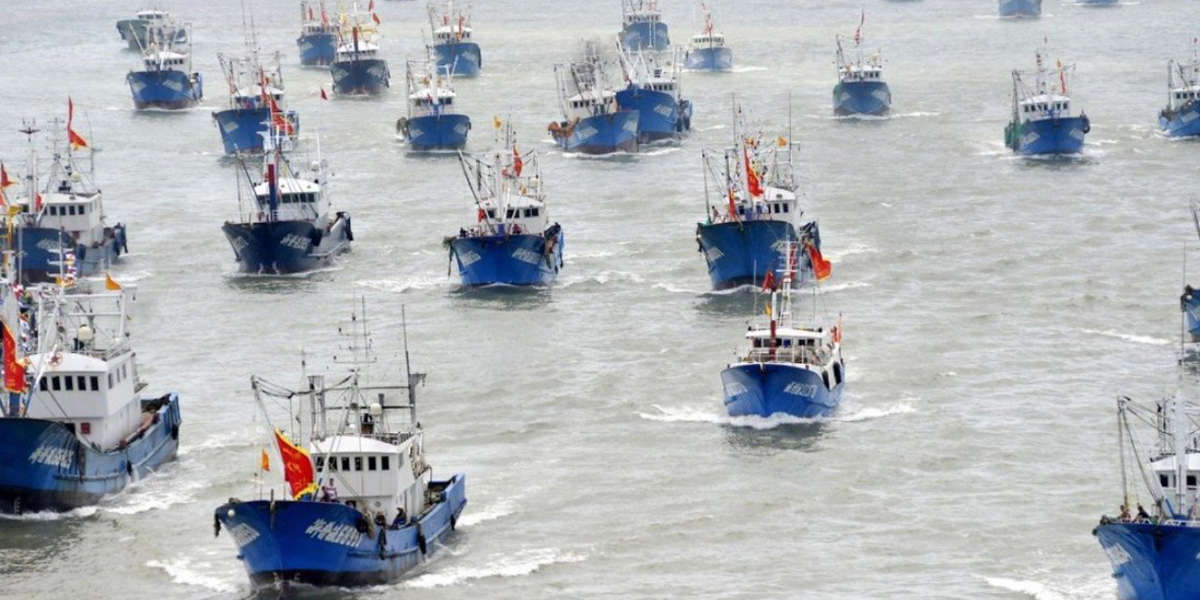In the picture
China's fishing fleet in Zhejiang province [China Foto Press].
Navigating in dangerous waters
Global maritime security is going through one of its most delicate moments in decades. Not only because of the specter of a new cold war, which would have an eminently maritime/naval component and which seems to be getting closer and closer, but also because of the wide range of risks and threats (conventional and non-conventional) present throughout the waters of the entire globe.
Thus, both NATO and the European Union are currently navigating dangerous waters. The threats to our security and to the current international order make maritime security and naval power instruments which, together with the rapid technological evolution and its impact on the armaments industry, will be fundamental to prevail in what is already known by many as the "maritime century".
China and the Indo-Pacific
The Indo-Pacific is today the center of gravity of world security for various political, economic and military reasons, and also has an eminently maritime geography. If a third world war were to break out at some point (which would be, by the way, very different from the previous two), this region would undoubtedly be one of the main protagonists, either because it would be where it would begin or because it would quickly become one of its main theaters of operations.
China has the largest navy and fishing fleet in the world in terms of issue of vessels. While the issue number of ships a navy has is not 'the' deciding factor in determining its actual capabilities, it is certainly one of them. Its territorial and commercial ambitions have turned the region into a time bomb, with naval capabilities to prevent the United States from operating normally in the region, and with harassment of its neighbors that, despite being below the threshold of military action (within the so-called 'gray zone'), threatens to escalate into armed conflict.
China aspires to exercise sovereignty over the entire South China Sea using the so-called 'Nine-Dash Line', and has fortified its coasts to prevent the US Navy and its allies from navigating in the region with a powerful demonstration of denial of access to and navigation in the region (A2/AD). With its land-based artillery capabilities, particularly its DF-26 and DF-31B missiles, the US Navy and its allies would face great difficulties in assisting Taiwan inthe face of a Chinese invasion - primarily, the dilemma of having to choose between venturing into the first island chain and risking being hit by Chinese missiles, or staying out of range but unable to support Taiwan in the face of an amphibious invasion.
In addition, territorial disputes with several of its neighbors (Philippines, Vietnam and Taiwan) have resulted in countless incidents in recent years, in which China has deployed a whole range of hybrid naval tactics to harass and intimidate vessels sailing in waters that Beijing considers to be its own (even though they are not).
In August 2023, the Philippine Coast Guard had several encounters with their Chinese counterparts, who fired pressurized water cannons at them as they were about to carry out a resupply operation near Ayungin Atoll. Also, numerous cases of blockades of Philippine and Vietnamese vessels have been reported in recent months, often because the latter were operating in waters that China considers its own.
Recently, two Royal Australian Navy divers were injured while removing fishing nets that had become entangled in one of the propellers of the frigate HMAS Toowoomba. Despite being in international waters within Japan's Exclusive Economic Zone, a Chinese destroyer approached the area, and despite being alerted by the Australian vessel that divers were in the water, turned on its hull sonar, causing minor injuries to the two divers.
Maritime trade
In the Eastern Mediterranean and Black Sea, conflicts in Ukraine and Israel threaten to cause serious damage to global trade (over 80% of which transits by sea). The status in Israel has led to the largest naval concentration in the Mediterranean since the Cold War, in a region through which important trade routes using the Suez Canal pass.
The Ukrainian War has left very significant episodes as far as naval strategy is concerned, with the irruption of unmanned surface drones to attack Russian vessels. The employment of these vessels, relatively low cost and with a very high size-impact ratio, have allowed Ukraine to confront the Russian Black Sea fleet. However, the conflict has also dealt a severe blow to maritime (and, above all, commercial) security in the region, since Russia in July 2023 ended the agreement grain export by which the two belligerents had agreed a year earlier to respect exports of grain, fertilizer and other products leaving Ukrainian ports.
Russia has set up a naval blockade at internship threatening to attack any vessel entering or leaving Ukrainian ports, under the premise that all such vessels will be considered to be carrying arms and ammunition for the Zelensky government. This, coupled with the enormous number of anti-ship mines that have been laid in the waters of the Black Sea since the beginning of the conflict, has made this region a hostile environment for the maritime trade on which so many countries depend.
Piracy and threats from non-state actors
As for Israel and Gaza, the consequences of the conflict have also spread to the Red Sea and the Gulf of Aden, where Yemen's Houthis (directed from Tehran) are now threatening regional maritime security after years of leave activity. Along with the launching of numerous missiles and drones towards Israel that have been intercepted by American destroyers since mid-October, numerous cases of hijackings of cargo ships have been reported in the region.
On November 19, the Houthis boarded by helicopter and subsequently hijacked the Galaxy Leader, a freighter operated by the Japanese NYK business and suspected of having ties to an Israeli businessman. A few days later, the U.S. destroyer USS Mason arrested five people suspected of attempting to hijack another freighter in the Gulf of Aden. The pirates had attempted to hijack the vessel, but when this proved impossible given the actions of its crew, they tried to flee to Yemen in one of the freighter's skiffs. Shortly afterwards, on November 24, a group of Somali pirates belonging to the Eyl militia hijacked the Iranian-flagged fishing vessel Almeraj-1, for which they are demanding a reward of $400,000 and have threatened to use for further hijackings if the money is not delivered.
Thus, the piracy that significantly affected the Gulf of Aden region and the Indian waters off the coast of Somalia in the early 2000s is threatening to resurface. In 2008, the European Union launched its mission statement against piracy in the region, known as Operation Atalanta, which since 2019 (following the United Kingdom's exit from the Union) has been led by Spain with the Rota base (in Cadiz) as its headquarters. Thanks to it, piracy has been reduced to a minimum in recent years, despite having resurfaced slightly further west, in the Gulf of Guinea.
Underwater critical infrastructures
In addition to all these security threats, there is alsothe increasing vulnerability of critical undersea infrastructures, especially undersea cables and gas pipelines. These infrastructures are vital for the global Economics , as well as for energy supply, and are largely unprotected against sabotage such as those of Nord Stream in the Baltic Sea, or the numerous incidents with submarine cables in the North Sea and the Mediterranean in recent years.
Countries such as France (which has the second largest Exclusive Economic Zone in the world) or the United Kingdom have already begun to work in earnest on strategies to strengthen their capabilities, which revolve around surveillance of the seabed using unmanned underwater vehicles capable of operating at great depths. Other NATO countries have also begun to take action, as evidenced by the establishment of the Submarine Infrastructure Coordination Cell, which NATO recently set up to promote the interoperability of its members in this field.
However, we face a problem that is difficult to eliminate completely, since Russia and the other countries that carry out these actions will always have a slight advantage: the respect of NATO countries for international law, which they deliberately ignore.
Naval power
Finally, a factor core topic that further aggravates the picture described so far is the state of European navies and the shipbuilding industry in most NATO countries. After several decades of relative stability immediately after the end of the Cold War, virtually all European navies and the industrial base supporting them were contracting significantly. The promise of an 'end of history' and perpetual world peace as prophesied by Professor Francis Fukuyama led national governments to reduce national expense and defense investments.
Thus, while potential adversaries such as Russia and China have gradually grown stronger, NATO now finds itself with insufficient naval capabilities and maritime presence to meet all the existing challenges. The United States, hitherto the undisputed arbiter in the global oceans, finds itself unable to maintain an adequate naval presence in all the places that require it, with strategic needs for which its fleet is too small, with a depleted industrial base after years of inactivity and the subsequent loss of experience, and unable to build ships at the necessary pace. Alongside this, their European allies face similar problems in strengthening the capabilities needed to support them.
At final, both NATO and the European Union are currently navigating in dangerous waters. However, they lack the necessary elements to protect their common interests. Faced with a wide range of threats to our security and to the current international order, maritime security and naval power are now the main instrument they will have to resort to in order to prevail in what many are already calling the 'maritime century'.
US Navy mobilizes two strike groups to Western Mediterranean
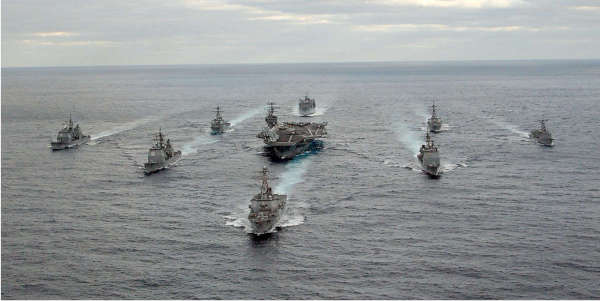
A US Navy attack group , with the aircraft carrier surrounded by cruisers and guided missile destroyers [US Navy].
October 9 (updated October 15)-In the early morning hours of October 7, Israel awoke to a surprise attack by Hamas. A coordinated and highly planned invasion by land, sea and air, Palestinian forces seized several Israeli towns. In the process, hundreds of people have been taken hostage, thousands have been wounded and the death toll on both sides now stands at over a thousand.
In the face of the attack, dubbed 'Operation Al Aqsa Flood', Israel has mobilized its entire armed forces and its reservists between the ages of 18 and 60 to go and fight on two fronts: to the north, on the border with Lebanon, against Hezbollah attacks and bombings; and to the south, with an air and ground campaign against Hamas forces infiltrating its territory and against the Gaza Strip, which they have declared they will leave "at tarmac level."
For more than 24 hours, constant salvoes of missiles from Gaza rained down on various points in Israel, most of them intercepted by the anti-missile defense known as the "steel dome". On the Israeli side, their air forces carried out a series of bombing raids on buildings where Hamas munitions or a Hamas presence was believed to be present; but they have also destroyed numerous civilian buildings such as the Al-Amin Muhammad mosque, which was completely reduced to rubble.
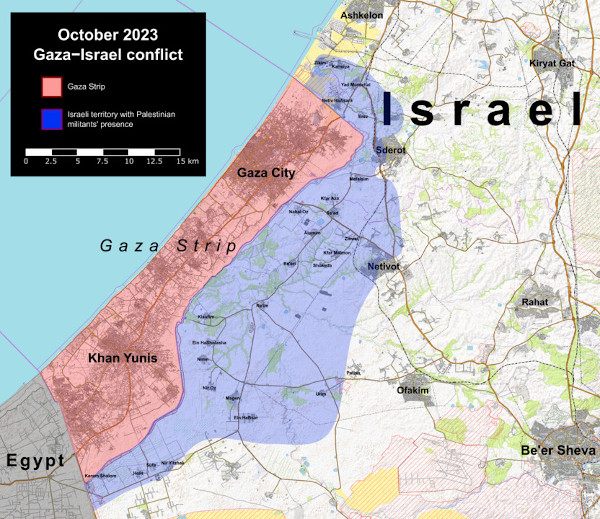
Faced with the weaknesses shown by the Israeli army, and the fear of a possible escalation, the US Navy has mobilized the group attack issue 12, with its most modern aircraft carrier at present (the USS Gerald Ford), the Wayside Cross guided missile class Ticonderoga (USS Normandy), and four guided missile destroyers class Alreigh-Burke (USS Thomas Hudner, USS Ramage, USS Carney and USS Roosevelt). The American aircraft carrier was scheduled to make a visit to the port of Marseille, in southern France, along with its escorts. But in view of the seriousness of the events, the Secretary of Defense has announced that they were going to send it immediately to the other side of the Mediterranean. In a subsequent order, the Pentagon decided to send a second attack group to the area, organized around the USS Dwight D. Eisenhower.
These strike groups are composed of a capital ship (of great strategic value) such as an aircraft carrier or a helicopter carrier, several destroyers, cruisers or frigates as escorts. Aircraft carriers are a fundamental advantage since they act as small airfields at sea, being able to transport dozens of combat aircraft to the theater of operations, thus being tools of "strategic projection". The task of the escorts (which sail in front of and to the sides of the capital ship) is to protect the latter from any attack, which despite its high strategic value, is much less armed to defend itself from any attack. These destroyers and cruisers (and in the case of other countries such as Spain, frigates) is to control the airspace, surface and submarine space from any potential threat, equipped with anti-aircraft, anti-ship and anti-submarine defenses to do so (but also with missiles to carry out attacks on land targets).
This move has been greeted by Hamas and its allies in defiance. agreement According to group spokesman Hazem Qassem, the move is "a participation in the aggression against our people" and "an attempt to strengthen the morale of a faltering Israeli force". The group assures that the American decision does not frighten them, and warns of the consequences that their participation could trigger.
These ships, armed with the latest missile and electronic warfare technology, have very large firepower, and if employed (which at the moment is unlikely), would cause very significant damage to their targets ashore. These include Harpoon anti-ship missiles, RIM-66M and RIM-156 surface-to-air missiles, and Wayside Cross Tomahawk missiles. In addition, neither Hamas nor Hezbollah has a missile defense capable of neutralizing an attack by U.S. ships.
On the other hand, and although it is something the Americans never announce given that their main tool is surprise, at this time there are probably several attack and ballistic missile submarines in the vicinity. It is likely that one or two units from the class Florida (armed with 150 Tomahawk missiles), and some other unit from the attack submarines class Los Angeles and Virginia. The capabilities of these submarines would completely nullify any goal, but as we say, their use in this conflict will be purely deterrent, since their intervention could escalate the conflict and involve third countries.
At the expense of the role to be played by the US forces sent to the region, there is no doubt that the naval dimension will play a role core topic in the conflict, given the geographical nature of the theater of operations (an area with a wide coastline). The Israeli Navy has managed to neutralize in the last few hours dozens of attempted attacks from the sea, eliminating several attack boats. Its special forces, Shayetet 13 (equivalent to the U.S. Marines) have managed to capture on the beach one of the highest ranking officers of the Hamas Navy.
New blow to the Russian Navy in the Black Sea
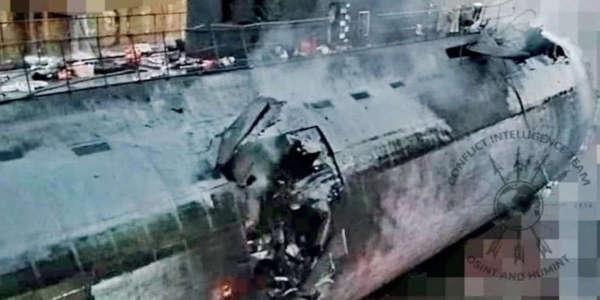
Recently circulated image showing damage to the submarine 'Rostov-on-Don' [Kyiv Post/Twitter].
September 25-Russia's naval forces in Sevastopol are showing particular vulnerability. On September 13 there was a new Ukrainian attack on the Russian Black Sea Fleet, which has already received previous blows so far in the war, and on the 22nd its HQ was shelled.
The recent attack on ships was carried out for the first time against units that were in dry dock: the Russian submarine of the class Kilo 'Rostov-on-Don' and the amphibious landing ship of the class Ropucha 'Minsk'. Both were in dry dock at the Sevastopol naval base, one of the most important and strategically relevant for the Russian Navy.
The attack, which took place during the night, was carried out with missiles from Wayside Cross Storm Shadow/SCALP-EG provided to Ukraine by the UK and France, launched from a Sukhoi Su-24M. The missiles penetrated the hull of the submarine before exploding, rendering it virtually useless. The most significant damage affected the bow section, where the Wayside Cross torpedoes and missiles carried by the submarine are stored.
The submarine 'Rostov-on-Don' is one of the four units of the upgraded class Kilo at Moscow's disposal. With the damage sustained in the bombardment, Ukraine once again scores a small victory in its favor, with the added value that this is the first submarine Russia has lost in combat (even while in dry dock) since the days of World War II.
Thus, Ukraine puts both vessels out of service at least for the duration of the war, and it remains to be seen whether both will ever be able to sail again. Moreover, the damage is even more significant if one takes into account that the work to remove both vessels from the dry dock will be more than complex (and costly), and the damage to the dry dock will also jeopardize the repair work for other Black Sea Fleet vessels.
The incident constitutes one of the most recent events in the long list of blows dealt to the Black Sea Fleet since the beginning of the war. The first of these, the sinking of the Wayside Cross guided missile class Slava 'Moskva' in April 2022, was followed by numerous attacks on Russian vessels in the Black Sea. Since then, the vast majority of them have involved employee unmanned vehicles, known in English as Unmanned Surface Vehicles (USVs), which are having a major impact on naval warfare. This is the case of the attacks on the Sevastopol base in October 2022, or the attacks on several ships in the Black Sea during the summer of 2023.
In addition, on September 22, Ukraine carried out a successful attack on the city of Sevastopol, in which it managed to shell the Black Sea Fleet Headquarters building, against which it launched a missile.
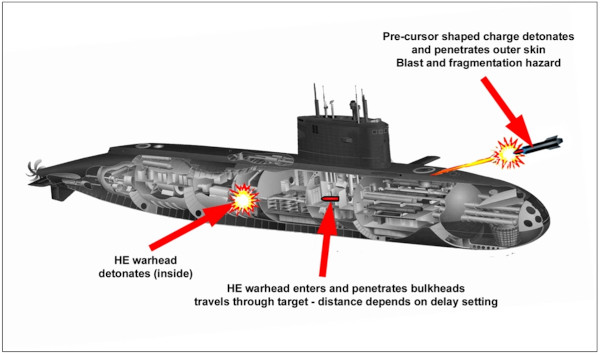
ALSO READ
The Black Sea Grain Initiative is Dead: Implications for Maritime Security in the Black SeaJuly 21, 2023.

